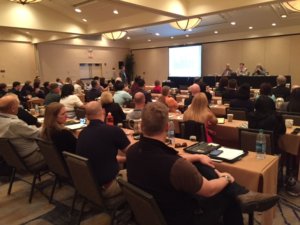
Architecture and engineering firms are still learning how to cope with a growing cybersecurity threat. According to this year’s Global Application and Network Security Report from Radware, nearly half of all companies experienced a cyber ransomware attack in 2016. Vulnerability to loss of personal data, exposure of sensitive or proprietary information, etc., is also on the rise. Tim Corbett of SmartRisk LLC, a longtime affiliate of a/e ProNet, has recently analyzed the report findings. He writes that the gravest irony is that while “Employees are the first line of defense” against cyberattacks, they are also a company’s “greatest cyber security weakness.”
Employees’ personal habits regarding company data and digital interactions open doors for hackers, viruses, and the siphoning of information. If your employees aren’t aware of basic threats and/or best practices regarding cybersecurity, your firm is more likely to lose out. The costs of these attacks can be severe. They are also avoidable. SmartRisk’s post recommends regular and up-to-date cybersecurity trainings for your firm “[t]o obtain a broad understanding, and buy-in from the entire organization.”
Arm yourself with SmartRisk’s Checklist
According to SmartRisk, cybersecurity training should take place annually. Corbett offers a checklist for these trainings. Remember to include “all members of the organization, including senior management… so they are knowledgeable of recent trends, monitoring methods, and controls used to prevent the installation of malicious code on the organization’s computer systems.” He also recommends making cybersecurity training a standard protocol for new hires. It’s probably a good idea, as well, to encourage your IT department to be accessible for even basic questions on cybersecurity. Demystifying the response to the threat will empower your employees to be proactive in protecting the company’s interests.
October is Cybersecurity Awareness Month, so you can find a/e ProNet’s past posts on related issues here:
Federal Trade Commission Releases How-To Cybersecurity Guide (Oct 2016)
Cyber Security Awareness & Last Week’s DDOS Hack (Oct 2015)
As always, if you have further questions, please contact your a/e ProNet broker.

 For the last few sunny days, a/e ProNet members from across the country have gathered in Scottsdale, Arizona for our annual Spring Meeting (March 1-3). a/e ProNet brokers are independent. Technically, we operate as competitors. Membership is by invitation only. We come together voluntarily as recognized leaders in our industry, meeting the insurance needs of architects and engineers. Our combined premium volume, experience, and national reach make our meetings an attractive target for insurance companies, premium finance companies, and other professionals. With our two annual meetings, we keep our fingers on the pulse of the insurance industry and advocate for our clients.
For the last few sunny days, a/e ProNet members from across the country have gathered in Scottsdale, Arizona for our annual Spring Meeting (March 1-3). a/e ProNet brokers are independent. Technically, we operate as competitors. Membership is by invitation only. We come together voluntarily as recognized leaders in our industry, meeting the insurance needs of architects and engineers. Our combined premium volume, experience, and national reach make our meetings an attractive target for insurance companies, premium finance companies, and other professionals. With our two annual meetings, we keep our fingers on the pulse of the insurance industry and advocate for our clients.